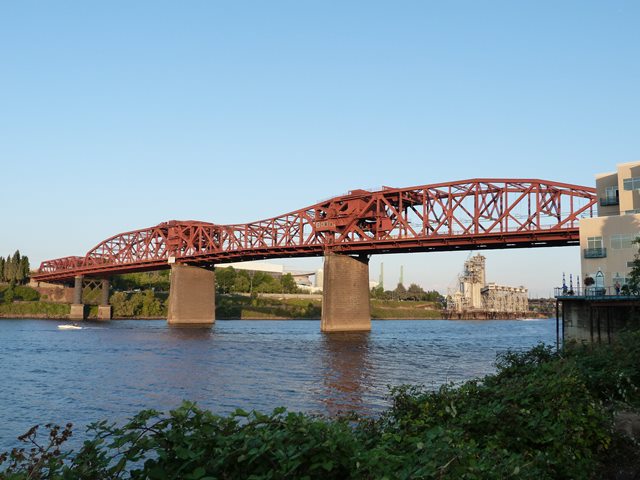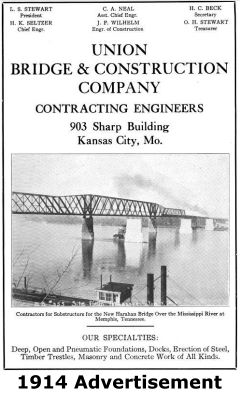We Recommend:
Bach Steel - Experts at historic truss bridge restoration.
Broadway Bridge

Primary Photographer(s): Nathan Holth
Bridge Documented: August 22, 2014 and September 3, 2018
Broadway Over Willamette River and Various Streets and Railroad
Portland: Multnomah County, Oregon: United States
Metal 12 Panel Rivet-Connected Baltimore Through Truss, Movable: Double Leaf Bascule (Rall) and Approach Spans: Metal 11 Panel Rivet-Connected Pennsylvania Through Truss, Fixed
1913 By Builder/Contractor: Pennsylvania Steel Company of Steelton, Pennsylvania and Engineer/Design: Ralph Modjeski
Not Available or Not Applicable
278.0 Feet (84.7 Meters)
1,742.0 Feet (531 Meters)
45.6 Feet (13.9 Meters)
1 Main Span(s) and 6 Approach Span(s)
6757000000000

View Information About HSR Ratings
Bridge Documentation
View Archived National Bridge Inventory Report - Has Additional Details and Evaluation
View Historic American Engineering Record (HAER) Documentation For This Bridge
HAER Drawings, PDF - HAER Data Pages, PDF - HAER Data Pages Addendum, PDF
View Historic Resource Inventory Sheet For This Bridge
HAER Documentation, Willamette River Bridges - Data Pages - Drawings -Timeline

This bridge is one of only a few Rall type bascule bridges in existence, and among those is significant as the largest Rall bascule in the world. This unusual bascule design, in simplest terms, is a variation of a trunnion bascule that features a main trunnion that is inside a roller which rolls back on a track as the bridge is raised. View this bridge in Chicago to learn more about the Rall bascule and its patented design, invented by Theodor Rall. The patent for this bascule was controlled by Charles Louis Strobel's company, Strobel Steel Construction Company. This prominent company built many movable bridges (not just Rall bascule bridges) in Chicago and elsewhere. For a fee, they provided the right to use their patented design for the Broadway Bridge's bascule span. It is unclear what if any design services they may have provided. The bridge as a whole was designed by Ralph Modjeski, one of the most prolific and famous bridge engineers in American history. Pennsylvania Steel Company of Steelton, Pennsylvania was the superstructure and mechanical contractor, while the Union Bridge and Construction Company of Kansas City, Missouri built the substructure.
The bridge features fixed Pratt and Pennsylvania through truss approach spans. The through truss bascule span is carefully designed to that the ends of the span blend into the fixed Pennsylvania through truss spans that flank the bascule span.
The bridge is an uncommon example of a high level bascule bridge. In other words, the bridge was built with enough clearance that it would only need to open for very tall boats. The bridge is also unusual because its main span (the bascule span) with its 278 foot span is shorter than the length of individual approach spans including the flanking Pennsylvania through truss spans which are 297 foot spans, and one of the other Pennsylvania through truss approach spans which is 286 feet.
The original spans of this bridge retain good historic integrity of design, materials, and appearance. However, the western end of the bridge originally had a Pratt through truss span that has been demolished and replaced apparently to add a ramp to Lovejoy Street. The loss of the riveted truss span is a substantial and unfortunate alteration.
The below drawing shows the bridge prior to the demolition of the Pratt truss span at the western end.
Information and Findings From Oregon's Historic Bridge InventoryDescription 278-ft double-leaf Rall-type bascule main span with four fixed Pennsylvania-Petit though trusses and one Pratt though truss secondary spans. The approach spans are steel plate girders. Designer Ralph Modjeski, Chicago; Strobel Engineering, Chicago (Bascule Span) Builders Pennsylvania Steel Co., Steelton, Pennsylvania (Superstructure); Union Bridge and Construction Co., Kansas City (Substructure) Significance As the first bascule span in Portland, the city explored many options for its design. This exploration led to the choice of the patented Rall bascule design, thought to be the cheapest of the proposed types. The rare Rall-type bascule uses large Rall wheels that enable the bascules to roll backward and upward as they open in order to clear a wider channel. In addition to the unique main span, the bridge also features distinctive granite-faced and topped piers on concrete-filled pneumatic caissons. Character Defining Features Bascule mechanism, Location, Decorative railing, Piers, Structure type Alterations Major alterations including the replacement of the deck, sidewalks, electrical system for the bascule, and adding the Lovejoy Street approach. Architectural Property Description The Broadway Bridge opened to traffic in April 1913, spans the Willamette River in downtown Portland, Oregon, at River Mile 11.7, just downstream from the Steel Bridge, within the core of the central commercial district of the city. Comprised of six steel through-trusses, the center span is a 278-foot-long, double-leaf Rall bascule and the overall length of the structure is 1,613 feet. The Broadway Bridge was designed by Ralph Modjeski, with the operable, Rall span designed under patent by the Strobel Steel Construction Company of Chicago, Illinois. The steel superstructure of the bridge was built by the Pennsylvania Steel Company. Union Bridge and Construction Company built the masonry substructure. The bridge is owned and maintained by Multnomah County. History The Broadway Bridge, the first bascule or drawbridge to be constructed across the Willamette River in Portland, Oregon, was completed in April 1913. The bridge was designed by noted bridge engineer Ralph Modjeski with a Rall bascule designed by the Strobel Steel Construction Company of Chicago, Illinois. The Broadway Bridge is of statewide significance for its role within Portland's transportation and development history as the first trans-Willamette River bridge to be constructed on an entirely new alignment in the 20th century. Its construction was a response to the increased cross-river traffic north of the traditional downtown, as Portland's population and business center grew in the early part of the 20th century. The Broadway Bridge is additionally of national significance under Criterion C as one of the few surviving examples of the patented Rall-type bascule, an early alternative to the more popular bascule forms that dominated most movable bridge construction. One of only three Rall bridges still in operation in the United States, the Broadway Bridge is the largest Rall bascule to have ever been built and as such is a key exemplar of that technology. Nominated under the framework of the Willamette River Highway Bridges Multiple Property Document (MPD) and built within the first temporal period as defined by that document, the Broadway Bridge is of statewide significance under National Register eligibility Criterion A, Community Planning and Development and Transportation, for its association with the development of Portland and its transportation network between its construction in 1913 and the close of the period of significance for the MPD document in 1973. The Broadway Bridge is additionally of national significance under Criterion C, Engineering, as the oldest and largest example of the patented Rall-type bascule movable bridge design and technology known to exist. The period of significance under Criterion C is the date of construction, 1913. The Broadway Bridge meets all the general and the necessary specific registration requirements for listing under the MPD. Bibliography DeLony, Eric. Landmark American Bridges. Boston, MA: Little, Brown and Company, 1993. Bridge Considered Historic By Survey: Yes |
![]()
Photo Galleries and Videos: Broadway Bridge
Bridge Photo-Documentation
Original / Full Size PhotosA collection of overview and detail photos. This gallery offers photos in the highest available resolution and file size in a touch-friendly popup viewer.
Alternatively, Browse Without Using Viewer
![]()
Bridge Photo-Documentation
Mobile Optimized PhotosA collection of overview and detail photos. This gallery features data-friendly, fast-loading photos in a touch-friendly popup viewer.
Alternatively, Browse Without Using Viewer
![]()
Maps and Links: Broadway Bridge
Coordinates (Latitude, Longitude):
Search For Additional Bridge Listings:
Bridgehunter.com: View listed bridges within 0.5 miles (0.8 kilometers) of this bridge.
Bridgehunter.com: View listed bridges within 10 miles (16 kilometers) of this bridge.
Additional Maps:
Google Streetview (If Available)
GeoHack (Additional Links and Coordinates)
Apple Maps (Via DuckDuckGo Search)
Apple Maps (Apple devices only)
Android: Open Location In Your Map or GPS App
Flickr Gallery (Find Nearby Photos)
Wikimedia Commons (Find Nearby Photos)
Directions Via Sygic For Android
Directions Via Sygic For iOS and Android Dolphin Browser
USGS National Map (United States Only)
Historical USGS Topo Maps (United States Only)
Historic Aerials (United States Only)
CalTopo Maps (United States Only)





